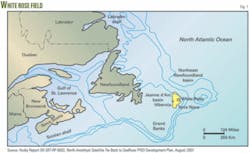North Amethyst, first White Rose satellite to be developed
North Amethyst is the first of several White Rose field satellite discoveries that Husky Energy Inc. plans to develop off Newfoundland.
Husky’s August 2007 development plan is now under review by the Canada-Newfoundland and Labrador Offshore Petroleum Board and, if it is approved, development drilling may commence in mid-2008. For drilling these subsea tied-in wells, the company recently secured Transocean Inc.’s mobile semisubmersible drilling unit GSF Grand Banks.
The petroleum board approved development of another satellite area, South White Rose extension, in September 2007. Also Husky is evaluating results of delineation drilling conducted in 2007 for West White Rose prior to submitting a development application for the project.
White Rose
White Rose field produces to the SeaRose floating production, storage, and offloading (FPSO) vessel. The SeaRose has a disconnectable turret for ice avoidance. Oil production from the field began on Nov. 12, 2005.
Husky, the operator, has a 72.5% working interest in White Rose, which lies on the eastern margin of the Jeanne d’Arc basin, about 350 km east of St. John’s (Fig. 1). Petro-Canada holds the remaining 27.5% interest in the field.
The field has three pools: North, West and South Avalon (Fig. 2). The South Avalon was the initial pool developed in the $2.35 billion project.
South Avalon is in 120 m of water, and Husky expects to recover 200-250 million bbl of 30° gravity oil from the pool.
Husky’s base production profile for White Rose predicts that the SeaRose will begin reaching the end of production plateau in 2008. As spare production capacity becomes available, subsea tie-back wells will start using this spare capacity.
The North Amethyst satellite tie-back involves a new glory hole with a capacity for up to 16 wells. In its August 2007 development plan, Husky estimates that the P50 (50% probability) recoverable oil from North Amethyst is 70 million bbl out of the 256 million bbl of oil in place. The plan expects the development will have a $1.3 billion (Can.) capital cost. Husky’s base-case estimate is that North Amethyst’s wells will have a maximum oil production of 62,900-75,500 b/d.
North Amethyst will produced from the Ben Nevis formation, which is 600 m shallower then in the South Avalon pool. In North Amethyst, a gas cap overlies the oil column and the properties are similar to those in the South Avalon.
The plan expects South White Rose and North Amethyst together to have 19-21 wells, including 7-8 horizontal oil producers, 10-11 water injectors, and 2 deviated gas injectors.
Husky plans for the water injection to support reservoir pressure in North Amethyst and will inject produced gas from North Amethyst into North Avalon for storage. Excess gas from South Avalon already is being injected into North Avalon. Husky expects to recover the injected gas from North Avalon in the future.
Husky’s development plan includes two possible scenarios of tying back the North Amethyst satellite (Fig. 3). In one case, satellite wells would tie back to the Sea Rose with dedicated flowlines and risers terminating at the buoy. This option requires modifying the FPSO turret, buoy, and topsides to accommodate the new flowlines, risers and umbilical. Also this case requires the Sea Rose to be disconnected and brought to shore for the modifications, possibly in summer 2010. In this case, Husky expects first oil from North Amethyst in fall 2010.
In the second scenario, North Amethyst would tie back through existing subsea infrastructure. This option would not require turret modifications and would delay topsides modifications to later, according to Husky’s proposed plan.
SeaRose FPSO
Husky advanced the planned maintenance turnaround for the SeaRose from the original August 2008 date to first-quarter 2008. The work entailed shutting in production in late January and early February for 13 days.
Husky said that it brought the schedule forward to address the problem of sediment buildup in the low-pressure separator, which had curtailed production to about 90,000-95,000 b/d. After the turnaround, production increased to about 130,000 b/d, Husky reported.
Combining the planned turnaround with the cleaning of the low-pressure separator, Husky expects the annual White Rose production in 2008 to be about the same as previously estimated.


